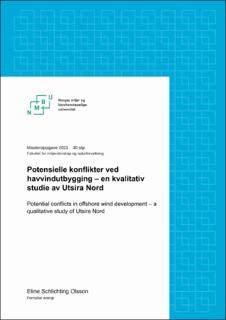| dc.contributor.advisor | Holden, Erling | |
| dc.contributor.author | Olsson, Eline Schlichting | |
| dc.coverage.spatial | Norway, Rogaland, Utsira | en_US |
| dc.date.accessioned | 2021-11-18T09:32:28Z | |
| dc.date.available | 2021-11-18T09:32:28Z | |
| dc.date.issued | 2021 | |
| dc.identifier.uri | https://hdl.handle.net/11250/2830239 | |
| dc.description.abstract | De siste årene har den landbaserte vindkraftutbyggingen i Norge økt betydelig. Imidlertid er vindkraft på land forbundet med mange konflikter som har ført til at det stadig blir vanskeligere å finne egnede og akseptable steder for fremtidig utbygging. Mange har dermed skiftet fokus fra vindkraft på land til de enorme havvindressursene og ser på havvind som en mulig løsning for å redusere konfliktene. Hittil har det vært lite utbygging av vindkraft til havs i Norge, men 12. juni 2020 åpnet Olje- og energidepartementet to havvindområder. Oppgaven har som formål å undersøke hvilke konflikter som kan oppstå ved utbygging av havvind på Utsira Nord. Ved bruk av kvalitativ metode er datamateriale samlet inn gjennom semi-strukturerte intervjuer.
Resultatene i oppgaven viser at det er fire potensielle hovedområder for konflikt som kan oppstå. I det første konfliktområdet er det bekymring for at utbyggingen ikke gir noen lokale eller nasjonale fordeler, og at strømmen eksporteres til utlandet eller bidrar til å elektrifisere den norske sokkelen, fremfor å sende strømmen inn på land. I det andre konfliktområdet påpekes det at innspill ikke har blitt hørt så langt i prosessen, og hvor det har vært manglende mulighet til å ha dialog med beslutningstakere. Det tredje konfliktområdet omhandler hvordan maritime næringer og lokalsamfunnet påvirkes av utbyggingen. Havvindparken vil være synlig fra Utsira sine utsiktspunkter som kan være forstyrrende for innbyggerne og tilreisende. Utsira er en populær destinasjon, spesielt for fugleinteresserte og utbyggingen kan føre til at fuglene forsvinner fra øya. Det kan oppstå konflikter med fiskeri som følge av ilandføring av sjøkabler og økt skipstrafikk hvor trål kjøres i senk og fiskefelt stenges i en lengre periode. Fisk og sjøpattedyr kan bli negativt påvirket av utbyggingen og kan i verste fall forsvinne fra området. Trafikksikkerheten kan reduseres ved at skipstrafikken blir presset til å gå mellom havvindparken og Utsira, eller hvis det blir opprettet seilingskorridorer i vindparken. Dette vil føre til økt kollisjonsfare mellom skip og vindturbiner. Havvindparken kan komme i konflikt med Forsvarets eksisterende skytefelt dersom deres nye skytefelt ikke blir åpnet som planlagt, og utbyggere får tildelt konsesjon i det overlappende området. Det fjerde konfliktområdet er manglende samordning og helhetlig planlegging, noe som kan føre til konflikt med de ulike maritime næringene og lokalsamfunnet. Derfor er det viktig med et helhetlig planleggingsverktøy som ivaretar disse interessene og som er rettslig forpliktende, både på lokalt og nasjonalt nivå. | en_US |
| dc.description.abstract | Over the last few years, the onshore wind energy development in Norway has increased considerably. However, onshore wind energy is associated with many conflicts that have made it increasingly difficult to find suitable locations for future development. Many have shifted their focus from onshore wind power to the enormous offshore wind resources and sees offshore wind as a possible solution to reduce conflicts. While there has been little development of offshore wind power in Norway so far, on 12 June 2020, the Ministry of Petroleum and Energy opened two offshore wind areas. The aim of the study is to investigate which challenges may arise during the development of offshore wind on Utsira Nord. Using a qualitative method, the data material is collected through semi-structured interviews. The results show that there are four potential main areas of conflict that can arise. In the first area of conflict, there is a concern that the development does not provide any local or national benefits, and that the electricity is exported abroad or contributes to electrifying the Norwegian continental shelf, rather than sending the electricity ashore. In the second area of conflict, it is pointed out that input has not been heard so far in the process, and it has been a lack of opportunity to have a dialogue with decision-makers. The third area of conflict involves how maritime industries and the local community are affected by the development. The offshore wind farm will be visible from Utsiras vantage points which can be disruptive to residents and visitors. Utsira is a popular destination, especially for birdwatchers, and the development could lead to the birds disappearing from the island. Conflicts with fishing can arise as a result of the landing of submarine cables and increased ship traffic where trawls are sunk, and fishing grounds are closed for a longer period. Fish and marine mammals can be negatively affected by the development and can, in the worst case scenario, disappear from the area. Traffic safety can be reduced by forcing ship traffic to go between the offshore wind farm and Utsira, or if sailing corridors are created in the wind farm. This will lead to an increased risk of collision between ships and wind turbines. The offshore wind farm may come into conflict with the Armed Forces existing firing range if their new firing range is not opened as planned, and developers are granted a license in the overlapping area. The fourth area of conflict is the lack of coordination and comprehensive planning that can lead to conflict with the different maritime industries and the local community. Therefore, it is important to have a comprehensive planning tool that looks after these interests and that is legally binding, both at local and national level. | en_US |
| dc.language.iso | nob | en_US |
| dc.publisher | Norwegian University of Life Sciences, Ås | en_US |
| dc.rights | Attribution-NonCommercial-NoDerivatives 4.0 Internasjonal | * |
| dc.rights.uri | http://creativecommons.org/licenses/by-nc-nd/4.0/deed.no | * |
| dc.title | Potensielle konflikter ved havvindutbygging : en kvalitativ studie av Utsira Nord | en_US |
| dc.title.alternative | Potential conflicts in offshore wind development : a qualitative study of Utsira Nord | en_US |
| dc.type | Master thesis | en_US |
| dc.description.localcode | M-FORNY | en_US |

